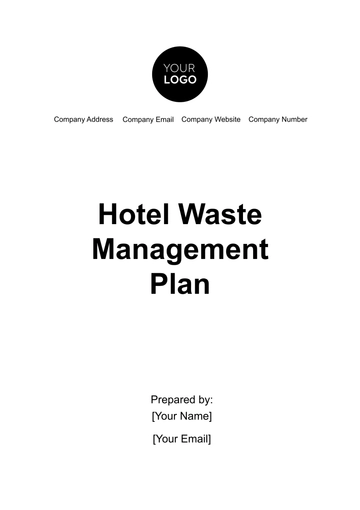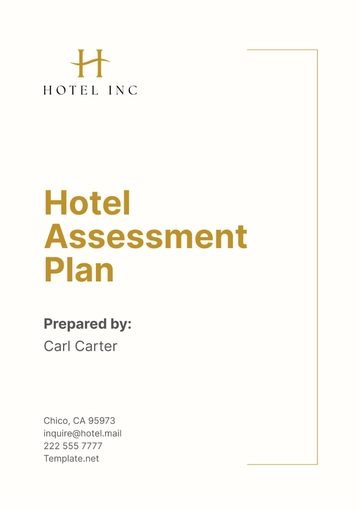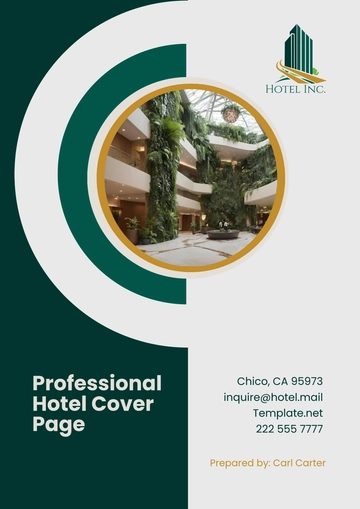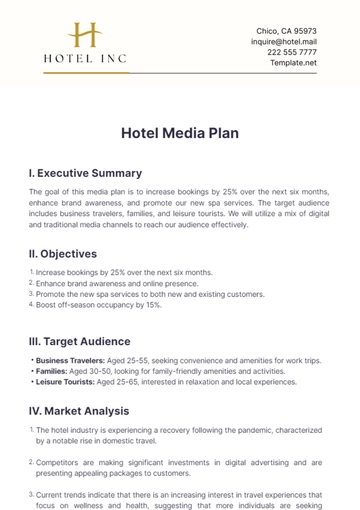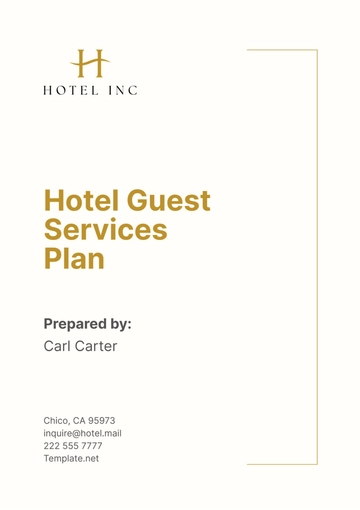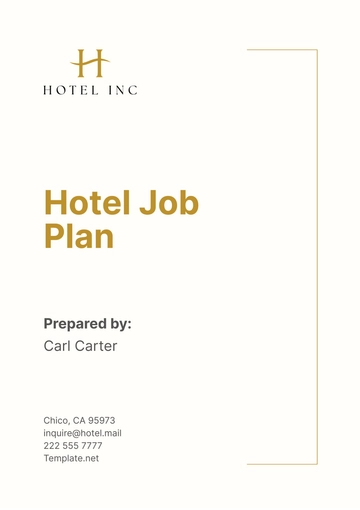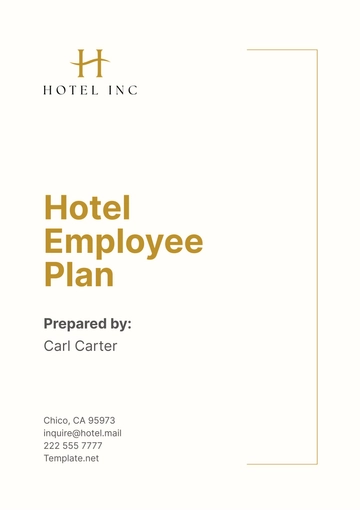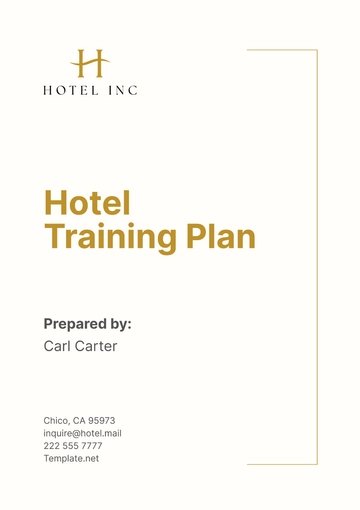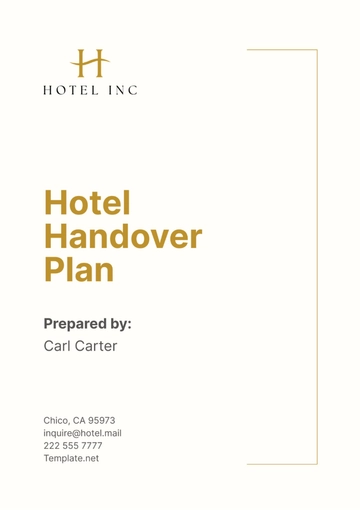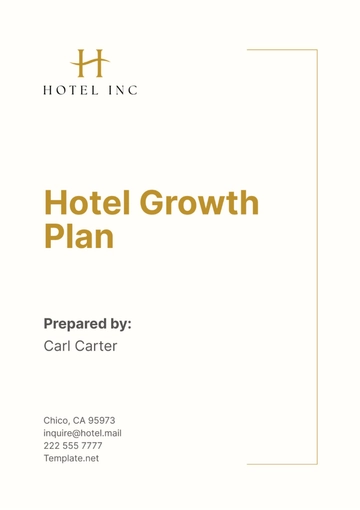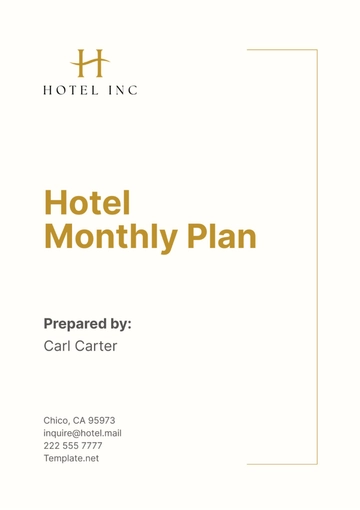Free Hotel Investment Plan
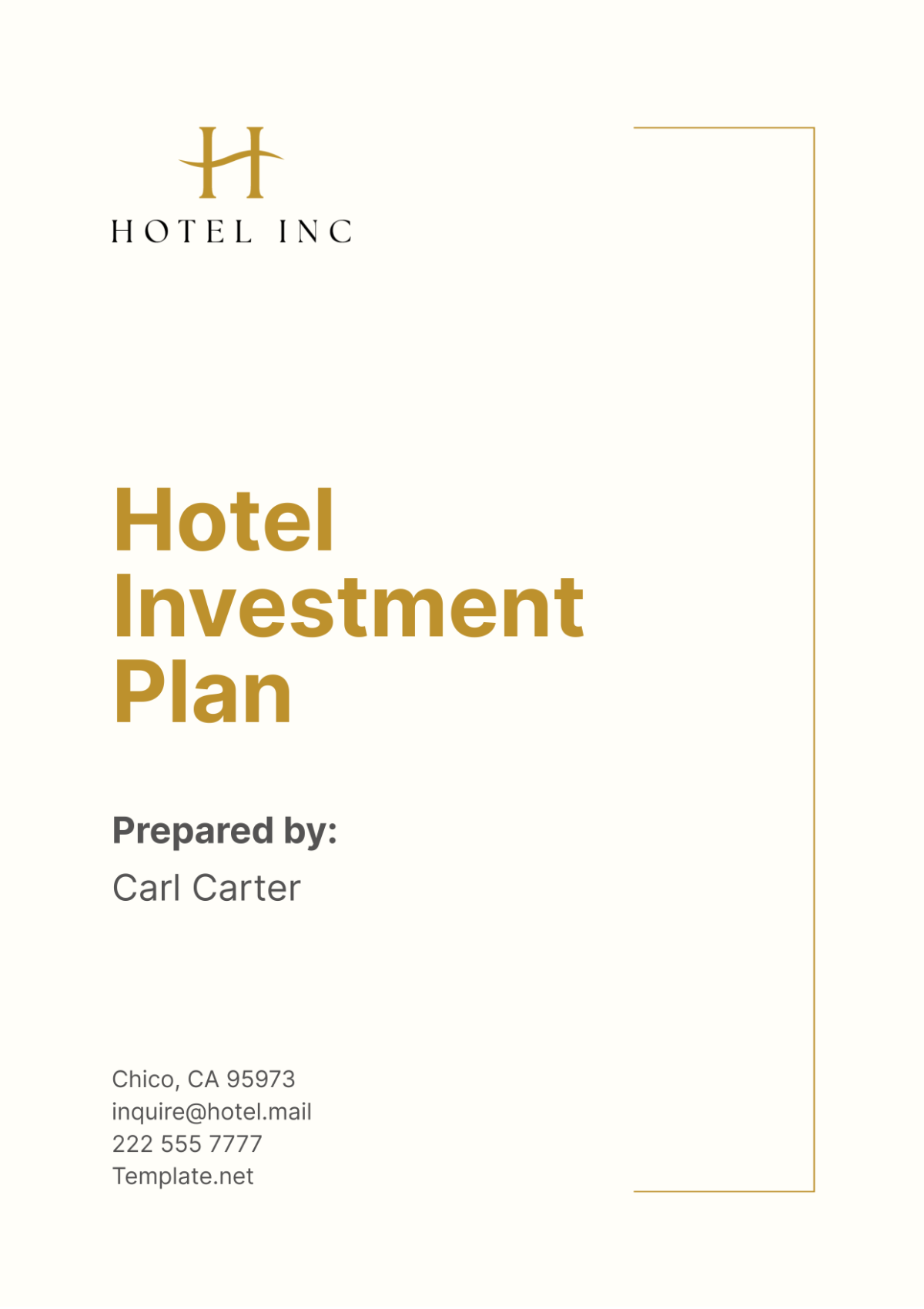
I. Executive Summary
This Hotel Investment Plan outlines the objectives, strategies, and financial forecasts for investing in the hospitality industry. Prepared by [Your Name] from [Your Company Name], this document aims to provide a comprehensive overview of the investment landscape, potential risks, and projected returns.
The primary focus is on identifying lucrative markets and properties while ensuring alignment with our overall corporate strategy. By leveraging market analysis, competitive assessment, and financial modeling, this plan sets the foundation for making informed investment decisions.
II. Market Analysis
The hospitality industry is poised for sustained growth, driven by increasing global tourism, economic expansion, and evolving consumer preferences. An in-depth market analysis reveals several critical trends and opportunities for hotel investment.
Key Market Trends
Increasing Tourism: According to the United Nations World Tourism Organization (UNWTO), international tourist arrivals are expected to reach 2 billion by 2050, growing at an annual rate of 3.3%. This growth is fueled by rising disposable incomes, improved connectivity, and a growing middle class, particularly in Asia and Latin America.
Rising Middle Class: The expansion of the middle class in emerging markets like China, India, and Brazil is leading to increased travel demand. These travelers are seeking diverse experiences, from luxury accommodations to affordable, quality lodging, creating opportunities across different hotel segments.
Experience Economy: Modern travelers prioritize unique and personalized experiences over traditional services. This shift is driving demand for boutique and themed hotels that offer distinct and memorable stays. Hotels that can provide authentic local experiences, cutting-edge technology, and personalized services are well-positioned to capture this market.
Regional Prospects
Urban Centers: Cities such as New York, London, Tokyo, and Dubai continue to be top destinations for business and leisure travelers. High demand for business travel and short city breaks makes urban centers attractive for hotel investment. Properties located near business districts, tourist attractions, and transportation hubs tend to perform exceptionally well.
Resort Destinations: Coastal areas, mountain resorts, and other leisure destinations are experiencing strong growth in leisure travel. Destinations like the Maldives, Bali, and the Caribbean are popular among tourists seeking luxury and relaxation. Investing in resorts in these regions can yield high returns, especially during peak travel seasons.
Emerging Hubs: Cities in developing countries are becoming increasingly accessible due to infrastructure improvements and enhanced air connectivity. Places like Ho Chi Minh City, Nairobi, and Lima are emerging as travel hubs. Early investment in these markets can capitalize on their growth potential.
By analyzing these market trends and regional prospects, we can strategically select locations for new hotel developments or acquisitions that align with current and future demand patterns.
III. Investment Objectives
The primary objectives of this hotel investment plan are to maximize returns while minimizing risks through strategic property selection, efficient management, and continuous market evaluation.
Specific Goals
Achieving an Occupancy Rate of at Least 75%: Maintaining a high occupancy rate is crucial for profitability. Strategies to achieve this include targeted marketing campaigns, competitive pricing, and exceptional guest services. Leveraging online travel agencies (OTAs), social media, and loyalty programs can help attract and retain guests.
Securing a Minimum Annual Return on Investment (ROI) of 12%: A robust ROI is essential for attracting and retaining investors. This will be achieved through careful financial planning, cost control, and revenue optimization. Diversifying revenue streams through additional services such as events, dining, and wellness facilities can also enhance profitability.
Establishing a Strong Brand Presence: Building a reputable brand is vital for long-term success. This involves delivering consistent quality, exceptional customer service, and memorable experiences. Investing in branding initiatives, staff training, and customer feedback systems will help in creating a strong and recognizable brand.
IV. Competitive Analysis
Understanding the competitive landscape is crucial for identifying differentiators and competitive advantages. This section evaluates the strengths and weaknesses of major hotel chains and independent operators within target markets.
Key Competitors
Major Hotel Chains: Large hotel chains such as Marriott, Hilton, and Hyatt have extensive resources and established brand recognition. They often benefit from economies of scale, sophisticated marketing strategies, and extensive loyalty programs. However, they may face challenges related to bureaucracy and slower adaptability to market changes.
Independent Operators: Smaller, independent hotels can offer unique, personalized experiences that differentiate them from larger chains. They are often more agile and can quickly adapt to market trends and guest preferences. However, they may struggle with limited resources, higher operational costs, and less brand recognition.
Competitive Factors
Service Quality: High-quality service is a significant differentiator in the hospitality industry. Hotels that consistently deliver excellent customer service, cleanliness, and comfort are more likely to achieve high guest satisfaction and repeat business.
Pricing Strategies: Competitive pricing is essential to attract guests, especially in markets with high competition. Dynamic pricing strategies that adjust rates based on demand, seasonality, and market conditions can help maximize revenue.
Customer Loyalty Programs: Loyalty programs are effective in retaining guests and encouraging repeat visits. Offering rewards, discounts, and exclusive benefits to loyal customers can enhance guest retention and brand loyalty.
Innovation in Guest Experiences: Innovating guest experiences through technology, unique amenities, and personalized services can set a hotel apart from competitors. Features such as mobile check-in, smart room controls, and curated local experiences can enhance guest satisfaction and differentiate a hotel in the market.
V. Financial Plan
The financial plan outlines the budget requirements, revenue projections, and financing options for the proposed hotel investments. A detailed profit and loss statement, cash flow analysis, and balance sheet provide a comprehensive financial overview.
Budget Requirements
Initial Investment: $50 million for property acquisition and development.
Operational Costs: $5 million annually for staffing, maintenance, and marketing.
Revenue Projections
Year 1: $10 million
Year 2: $12 million
Year 3: $14 million
Financing Options
Bank Loans: $30 million at an interest rate of 5% per annum.
Investor Equity: $15 million.
Internal Capital: $5 million.
Financial Tables
Profit and Loss Statement
Year | Revenue | Expenses | Net Profit |
|---|---|---|---|
2050 | $10,000,000 | $7,000,000 | $3,000,000 |
2051 | $12,000,000 | $7,500,000 | $4,500,000 |
2052 | $14,000,000 | $8,000,000 | $6,000,000 |
Cash Flow Analysis
Year | Cash Inflows | Cash Outflows | Net Cash Flow |
|---|---|---|---|
2050 | $10,000,000 | $7,500,000 | $2,500,000 |
2051 | $12,000,000 | $8,000,000 | $4,000,000 |
2052 | $14,000,000 | $8,500,000 | $5,500,000 |
Balance Sheet
Assets | Liabilities | Equity |
|---|---|---|
$60,000,000 | $35,000,000 | $25,000,000 |
Sensitivity Analysis
Scenario | Revenue Change | Expense Change | Net Profit Change |
|---|---|---|---|
Optimistic | +10% | +5% | +15% |
Pessimistic | -10% | +5% | -15% |
Budget Breakdown
Property Acquisition: $30 million for prime locations in high-demand markets.
Development and Renovation: $15 million for refurbishing and upgrading facilities to meet modern standards.
Marketing and Promotion: $3 million for launching effective marketing campaigns to build brand awareness and attract guests.
Staffing and Training: $2 million for recruiting and training skilled personnel to ensure high service quality.
Revenue Streams
Room Revenue: Primary source of income, projected to grow by 10% annually.
Food and Beverage: Significant contributor, with projections of $2 million in the first year, increasing to $3 million by the third year.
Events and Conferences: Additional revenue from hosting events, expected to generate $1 million annually.
Other Services: Includes spa, wellness, and recreational activities, contributing $500,000 annually.
By meticulously planning the financial aspects of the investment, we can ensure that our hotel projects are not only viable but also profitable, providing substantial returns to investors. The financial projections and sensitivity analysis offer a realistic view of potential outcomes, enabling us to prepare for various market conditions and make informed decisions.
VI. Risk Assessment
Investing in the hospitality sector, like any other industry, involves inherent risks. Identifying these risks and developing strategies to mitigate them is essential for ensuring long-term success and profitability. This section outlines the key risks associated with hotel investments and proposes comprehensive mitigation strategies.
Key Risks and Mitigation Strategies
Market Volatility
Risk Description: Fluctuations in the economy can lead to variations in travel demand, affecting hotel occupancy rates and revenues. Economic downturns, political instability, and natural disasters can significantly impact the hospitality industry.
Mitigation Strategies:
Diversification: Invest in properties across multiple regions and market segments to spread risk.
Flexible Pricing: Implement dynamic pricing strategies that adjust room rates based on real-time demand and market conditions.
Economic Indicators: Monitor global and local economic indicators to anticipate potential downturns and adjust strategies accordingly.
Competition
Risk Description: The hospitality industry is highly competitive, with numerous players vying for market share. New entrants and existing competitors can impact market dynamics and reduce profitability.
Mitigation Strategies:
Unique Selling Propositions (USPs): Develop and promote unique selling points that differentiate our hotels from competitors, such as exceptional service, unique experiences, or state-of-the-art amenities.
Customer Loyalty Programs: Enhance and expand loyalty programs to retain existing customers and attract new ones.
Market Research: Continuously conduct market research to stay ahead of industry trends and competitor strategies.
Regulatory Changes
Risk Description: Changes in regulations, such as zoning laws, labor laws, and environmental regulations, can impact hotel operations and profitability. Compliance with new regulations may require additional investment and operational adjustments.
Mitigation Strategies:
Legal Counsel: Engage legal experts to stay informed about regulatory changes and ensure compliance.
Proactive Planning: Develop contingency plans for potential regulatory changes and allocate resources for necessary adjustments.
Industry Associations: Participate in industry associations to stay updated on regulatory developments and advocate for favorable policies.
Operational Challenges
Risk Description: Operational issues such as staffing shortages, maintenance problems, and service quality can affect guest satisfaction and financial performance.
Mitigation Strategies:
Staff Training: Invest in ongoing training and development programs to ensure staff are well-equipped to deliver high-quality service.
Preventive Maintenance: Implement a rigorous preventive maintenance schedule to minimize disruptions and maintain property standards.
Guest Feedback: Regularly collect and analyze guest feedback to identify and address service quality issues promptly.
Changes in Consumer Behavior
Risk Description: Shifts in consumer preferences and travel behaviors can impact demand for certain types of accommodations and services.
Mitigation Strategies:
Market Analysis: Continuously monitor and analyze market trends and consumer behavior to adapt offerings accordingly.
Innovation: Invest in innovative solutions and amenities that cater to evolving guest preferences, such as technology-enhanced rooms and personalized experiences.
Flexible Offerings: Develop flexible packages and services that can be easily adjusted to meet changing consumer demands.
By adopting a proactive approach to risk management, we can safeguard our investments and ensure long-term profitability. Understanding and mitigating these risks is crucial for achieving our investment objectives and maintaining a competitive edge in the hospitality industry.
VII. Implementation Timeline
Successful execution of the investment plan requires a well-defined timeline with clear milestones and deliverables. This section provides a detailed schedule for each stage of the project, from initial market research and property acquisition to renovation and grand opening. Regular progress reviews and adjustments ensure that we stay on track to meet our investment objectives.
Timeline
Q1 2050: Market Research and Property Identification
Activity: Conduct comprehensive market research to identify high-potential locations and properties for investment.
Deliverables: Market analysis reports, shortlist of potential properties, and investment feasibility studies.
Milestones: Complete market research and identify top 10 target properties by the end of Q1.
Q2 2050: Property Acquisition and Initial Renovations
Activity: Finalize property acquisitions, negotiate purchase agreements, and commence initial renovation planning.
Deliverables: Signed purchase agreements, renovation plans, and project budgets.
Milestones: Secure property acquisitions and obtain necessary permits for renovation by the end of Q2.
Q3 2050: Final Renovations and Staff Training
Activity: Execute renovation projects, furnish and equip the properties, and recruit and train staff.
Deliverables: Completed renovation projects, fully equipped facilities, and trained staff ready for operations.
Milestones: Complete renovations and staff training, ensuring readiness for soft opening by the end of Q3.
Q4 2050: Soft Opening and Marketing Campaign
Activity: Conduct a soft opening to test operations, receive initial guest feedback, and launch a comprehensive marketing campaign.
Deliverables: Soft opening event, guest feedback reports, and marketing materials.
Milestones: Achieve a successful soft opening and generate initial bookings through marketing efforts by the end of Q4.
Q1 2051: Grand Opening and Full Operations
Activity: Host the grand opening event and commence full-scale operations, monitoring performance closely.
Deliverables: Grand opening event, operational performance reports, and customer satisfaction surveys.
Milestones: Ensure a successful grand opening and achieve targeted occupancy rates within the first quarter of operations.
Progress Reviews and Adjustments
To ensure successful implementation of the investment plan, regular progress reviews and adjustments are essential. Key activities include:
Monthly Progress Meetings: Conduct monthly meetings with the project team to review progress, address challenges, and make necessary adjustments.
Quarterly Performance Reviews: Evaluate financial and operational performance on a quarterly basis to ensure alignment with investment objectives.
Stakeholder Updates: Provide regular updates to stakeholders, including investors and management, to maintain transparency and accountability.
Continuous Improvement: Implement a continuous improvement process to refine strategies and operations based on feedback and performance data.
Milestone Summary
Phase | Activities | Deliverables | Milestones |
|---|---|---|---|
Q1 2050: Market Research | Conduct market research and property ID | Market analysis reports, property shortlist | Identify top 10 target properties |
Q2 2050: Property Acquisition | Finalize acquisitions, start renovations | Signed agreements, renovation plans, budgets | Secure acquisitions, obtain permits |
Q3 2050: Renovations & Training | Execute renovations, recruit and train staff | Completed renovations, trained staff | Ready for soft opening |
Q4 2050: Soft Opening | Soft opening, launch marketing campaign | Soft opening event, marketing materials | Successful soft opening, initial bookings |
Q1 2051: Grand Opening | Host grand opening, commence full operations | Grand opening event, performance reports | Achieve targeted occupancy rates |
By adhering to this implementation timeline, we can ensure a structured and efficient execution of the investment plan. Regular progress reviews and adjustments will help us stay on track, address any challenges promptly, and achieve our investment objectives.
This Hotel Investment Plan outlines a strategic approach to investing in the hospitality industry, emphasizing market analysis, investment objectives, competitive analysis, financial planning, risk assessment, and a detailed implementation timeline. By following these guidelines, [Your Company Name] is well-positioned to capitalize on growth opportunities in the hospitality sector and achieve significant returns on investment.
VIII. Conclusion
In conclusion, this Hotel Investment Plan serves as a strategic roadmap for navigating the complexities of the hospitality industry. By adhering to the outlined strategies and financial projections, we position ourselves for significant growth and profitability.
Prepared by [Your Name] at [Your Company Name], this plan underscores our commitment to excellence and our vision for becoming a market leader.
Contact Information:
[Your Company Name]
[Your Company Address]
[City, State, ZIP Code]
[Your Company Number]
[Your Company Email]
- 100% Customizable, free editor
- Access 1 Million+ Templates, photo’s & graphics
- Download or share as a template
- Click and replace photos, graphics, text, backgrounds
- Resize, crop, AI write & more
- Access advanced editor
Looking to secure funding for your hotel venture? Streamline your strategy with the Hotel Investment Plan Template from Template.net. This comprehensive tool provides a roadmap for investors, outlining key financial projections, market analysis, and risk assessment. Editable and customizable with our AI editor tool, it ensures your plan reflects your unique vision and goals. Unlock your hotel's potential today!
You may also like
- Finance Plan
- Construction Plan
- Sales Plan
- Development Plan
- Career Plan
- Budget Plan
- HR Plan
- Education Plan
- Transition Plan
- Work Plan
- Training Plan
- Communication Plan
- Operation Plan
- Health And Safety Plan
- Strategy Plan
- Professional Development Plan
- Advertising Plan
- Risk Management Plan
- Restaurant Plan
- School Plan
- Nursing Home Patient Care Plan
- Nursing Care Plan
- Plan Event
- Startup Plan
- Social Media Plan
- Staffing Plan
- Annual Plan
- Content Plan
- Payment Plan
- Implementation Plan
- Hotel Plan
- Workout Plan
- Accounting Plan
- Campaign Plan
- Essay Plan
- 30 60 90 Day Plan
- Research Plan
- Recruitment Plan
- 90 Day Plan
- Quarterly Plan
- Emergency Plan
- 5 Year Plan
- Gym Plan
- Personal Plan
- IT and Software Plan
- Treatment Plan
- Real Estate Plan
- Law Firm Plan
- Healthcare Plan
- Improvement Plan
- Media Plan
- 5 Year Business Plan
- Learning Plan
- Marketing Campaign Plan
- Travel Agency Plan
- Cleaning Services Plan
- Interior Design Plan
- Performance Plan
- PR Plan
- Birth Plan
- Life Plan
- SEO Plan
- Disaster Recovery Plan
- Continuity Plan
- Launch Plan
- Legal Plan
- Behavior Plan
- Performance Improvement Plan
- Salon Plan
- Security Plan
- Security Management Plan
- Employee Development Plan
- Quality Plan
- Service Improvement Plan
- Growth Plan
- Incident Response Plan
- Basketball Plan
- Emergency Action Plan
- Product Launch Plan
- Spa Plan
- Employee Training Plan
- Data Analysis Plan
- Employee Action Plan
- Territory Plan
- Audit Plan
- Classroom Plan
- Activity Plan
- Parenting Plan
- Care Plan
- Project Execution Plan
- Exercise Plan
- Internship Plan
- Software Development Plan
- Continuous Improvement Plan
- Leave Plan
- 90 Day Sales Plan
- Advertising Agency Plan
- Employee Transition Plan
- Smart Action Plan
- Workplace Safety Plan
- Behavior Change Plan
- Contingency Plan
- Continuity of Operations Plan
- Health Plan
- Quality Control Plan
- Self Plan
- Sports Development Plan
- Change Management Plan
- Ecommerce Plan
- Personal Financial Plan
- Process Improvement Plan
- 30-60-90 Day Sales Plan
- Crisis Management Plan
- Engagement Plan
- Execution Plan
- Pandemic Plan
- Quality Assurance Plan
- Service Continuity Plan
- Agile Project Plan
- Fundraising Plan
- Job Transition Plan
- Asset Maintenance Plan
- Maintenance Plan
- Software Test Plan
- Staff Training and Development Plan
- 3 Year Plan
- Brand Activation Plan
- Release Plan
- Resource Plan
- Risk Mitigation Plan
- Teacher Plan
- 30 60 90 Day Plan for New Manager
- Food Safety Plan
- Food Truck Plan
- Hiring Plan
- Quality Management Plan
- Wellness Plan
- Behavior Intervention Plan
- Bonus Plan
- Investment Plan
- Maternity Leave Plan
- Pandemic Response Plan
- Succession Planning
- Coaching Plan
- Configuration Management Plan
- Remote Work Plan
- Self Care Plan
- Teaching Plan
- 100-Day Plan
- HACCP Plan
- Student Plan
- Sustainability Plan
- 30 60 90 Day Plan for Interview
- Access Plan
- Site Specific Safety Plan


